- Home
- Stephen Hawking
A Stubbornly Persistent Illusion
A Stubbornly Persistent Illusion Read online
A STUBBORNLY
PERSISTENT
ILLUSION
A STUBBORNLY
PERSISTENT
ILLUSION
THE ESSENTIAL SCIENTIFIC WRITINGS OF ALBERT EINSTEIN
RUNNING PRESS
PHILADELPHIA • LONDON
© 2007 by Stephen Hawking
All rights reserved under the Pan-American
and International Copyright Conventions
This book may not be reproduced in whole or in part, in any form or by any means, electronic or mechanical, including photocopying, recording, or by any information storage and retrieval system now known or hereafter invented, without written permission from the publisher.
9 8 7 6 5 4 3 2 1
Digit on the right indicates the number of this printing
First paperback edition published in 2009
Library of Congress Control Number: 2007935658
ISBN-13 978-0-7624-3564-7
Cover design by Bill Jones
Interior design by Bill Jones and Aptara, Inc.
Edited by Jennifer Kasius
with David Goldberg
Typography: Adobe Garamond
This book may be ordered by mail from the publisher.
Please include $2.50 for postage and handling.
But try your bookstore first!
Running Press Book Publishers
2300 Chestnut Street
Philadelphia, PA 19103-4371
Visit us on the web!
www.runningpress.com
TEXT CREDITS
Selections from THE EVOLUTION OF PHYSICS: Reprinted with the permission of Simon & Schuster Adult Publishing Group, from The Evolution of Physics by Albert Einstein and Leopold Infeld. Copyright © 1938 by Albert Einstein and Leopold Infeld. Copyright © renewed 1966 by Albert Einstein and Leopold Infeld. All Rights Reserved.
Selection from THE MEANING OF RELATIVITY: Courtesy of Princeton University Press.
Autobiographical notes reprinted by permission of Open Court Publishing Company, a division of Carus Publishing Company, Peru, IL, from A. Einstein: Autobiographical Notes translated and edited by Paul Arthur Schilpp, first published in Albert Einstein: Philosopher-Scientist in The Library of Living Philosophers Series Volume VII, (c) 1949, 1951, 1970, 1979 by The Library of Living Philosophers, Inc., and the Estate of Albert Einstein.
Selections from OUT OF MY LATER YEARS: Reprinted with permission from The Philosophical Library, New York.
CONTENTS
INTRODUCTION BY STEPHEN HAWKING
THE PRINCIPLE OF RELATIVITY
RELATIVITY, THE SPECIAL AND GENERAL THEORY
SIDELIGHTS ON RELATIVITY
SELECTION FROM THE MEANING OF RELATIVITY, “SPACE AND TIME IN PRE-RELATTVITY PHYSICS”
SELECTIONS FROM THE EVOLUTION OF PHYSICS, “RELATIVITY, FIELD” AND “QUANTA”
AUTOBIOGRAPHICAL NOTES
SELECTIONS FROM OUT OF MY LATER YEARS
INDEX
INTRODUCTION
BY STEPHEN HAWKING
A few years ago the world celebrated the 100th anniversary of Einstein’s miracle year, the year in which he revolutionized physics in multiple ways with a series of astonishing new ideas that brought about profound changes in the way physicists view the universe. Human intuition tells us that space is a stage upon which the events of our lives play out, that time is governed by a universal clock. But in 1905 and the decade that followed, Einstein showed that space and time do not have identical meanings for observers sitting in a chair and those flying on a plane, those orbiting with us on earth, those having tea somewhere in the Virgo cluster, or those being sucked into a black hole.
Einstein’s ideas once stunned physicists. Today they are automatically incorporated into the equations and formalism learned by every undergraduate physics major. As long as those ideas stand up, Einstein wrote in one of the articles in this collection, the Germans will call him a “German savant,” and the English will call him a “Swiss Jew.” But if his ideas were ever discredited, he wrote, he would be a “Swiss Jew” for the Germans and a “German savant” for the English. Today there are few physicists left who remember Einstein as a living, breathing, and witty human being. Today his ideas of space and time intertwined are ingrained in popular culture, and described by writers several generations down. But the most lucid, not to mention entertaining, proponent of Einstein’s ideas has always been Einstein himself.
As he describes in this volume, Einstein’s 1905 special theory of relativity grew out of a simple observation. The theory of electromagnetism discovered by James Clerk Maxwell in the 1860s showed that whether you are moving toward or away from a beam of light, the light will always approach you at the same speed. This is not true of our experience in the everyday world. If you race away from an onrushing train you will survive for a few more seconds than if you race toward it (assuming that you don’t get the idea to jump sideways). In the former case the train’s speed of approach will be the difference between its speed and your speed (relative to the track). In the latter case its speed of approach will be the sum of your speeds. The same, according to Maxwell’s theory, does not apply to the light emitted from the train’s headlamps. How could the speed of light not appear slower in the former case and faster in the latter?
By speed we mean distance traveled divided by the time of the trip. And so, Einstein realized, if we are to take Maxwell’s theory at face value, we must alter our ideas of space and time. They are not fixed and unchanging, but adjust according to the observer, bending or stretching in just the way necessary to keep the speed of light constant. The same bending and stretching means of course that the speed at which the train itself approaches is also not the simple sum or difference I described above. But at speeds far less than the speed of light the difference in adding and subtracting derived by Einstein has only negligible effect. The same chain of logic, when taken further, requires also the equivalence of mass and energy, the reason that we can have atomic energy, and, unfortunately, atomic weapons. The details of Einstein’s reasoning, and the simple algebra behind it, are explained nowhere better than as found here, in Einstein’s own words.
Einstein’s theory of general relativity also grew from a simple observation. In Newton’s laws of motion there appears a quantity called the mass, which determines how easily an object accelerates when a force is applied. A massive truck is far more difficult to bring to speed than a far less massive Volkswagen. In Newton’s day three forces were known: electricity, magnetism, and gravity. The resistance to changing velocity in Newton’s laws of motion does not depend on which of those forces is applied. But Newton also discovered a law governing one of those forces, the force of gravity. In that law there appears another quantity which determines the amount of gravitational pull an object exerts, and the amount of gravitational pull it feels when in the presence of another object. That quantity is also called the mass. The two definitions of mass play quite different roles, but they are both called mass for good reason: it turns out they are one and the same. Why should they be equivalent? That question, plus Einstein’s brilliant logic, led to his realization that the scaffolding of space and time reacts to the presence of matter and energy.
“At a time like the present,” Einstein wrote, “when experience forces us to seek a newer and more solid foundation, the physicist cannot simply surrender to the philosopher the critical contemplation of the theoretical foundations; for, he himself knows best, and feels more surely where the shoe pinches.” Einstein was not narrowly interested in science, but also in the philosophy and language of science, and even its ethical implications. Some of his writings on those subjects, too, are include
d here. And. though Einstein wrote the above words in 1936, today is also a time in which physicists seek a new foundation, and a time in which such metaphysical issues have as much relevance as they did then. Today, since Einstein described space and time as dynamic variables, we see the universe as having not just one, but every possible history. We contemplate not only warped space and time, but whether the universe has additional dimensions. And we speculate about the very meaning of those concepts, and whether they are well defined or only approximate. We seek today a unified theory of all forces, as well as the framework of space and time in which we experience that the universe unfolds. It is a quest of which Einstein would have approved, and for which the remarkable work in this volume provides the foundation.
The Principle of Relativity
We can sometimes be fooled into thinking that great scientific breakthroughs, such as Einstein’s theory of relativity, were made from whole cloth and were completely independent of the work that came before. In “The Principle of Relativity,” we see the context out of which Einstein developed his theory, including some of the fundamental papers on which it was based.
In order to put this work in context, it is best to consider the state of physics at the turn of the twentieth century. In 1864, James Clerk Maxwell developed a complete theory of electricity and magnetism, and demonstrated that an electrical field is generated by a stationary charge, and a magnetic field is generated by a moving charge. These were seen as fundamentally different forces.
Hendrick A. Lorentz, in a series of papers published in 1895 and 1904, asked a seemingly simple question. What happens if a charge is sitting still, and we are running past it? Lorentz showed that to a moving observer, a stationary charge will “look like” a moving charge, and thus, an electric field will look like a magnetic one. Lorentz showed that to a moving observer, an electromagnetic wave will propagate at the same speed as to a stationary observer: the speed of light.
In 1905, Einstein reached a similar conclusion, that electric and magnetic forces are fundamentally related to one another and can appear in different proportions to observers moving at different speeds. But Einstein showed much more. He postulated that all physical laws must be equally valid in any “inertia reference frame” (traveling at fixed speed and direction) and that for any such observer the speed of light will be a constant.
These assumptions were well supported by both Maxwell’s theory and in the experimental work of Michelson and Morley, who showed that light travels at a constant speed regardless of the motion of the earth. Einstein posited that two observers with identical clocks and meter sticks who are moving relative to one another will each measure the meter stick of the other as foreshortened, and will measure the clock of the other as running slow. This seeming paradox lies at the heart of relativity.
The transformations between moving frames, conventionally known as the Lorentz transforms, lead to another important correction to Sir Isaac Newton’s laws of motion. According to Newton, applying a constant force to a body will accelerate it, and doing so indefinitely will increase the speed of the body without limit. However, Einstein’s theory of relativity showed that nothing can exceed the speed of light—Newton was wrong, but only in the limit where speeds approached that of light.
Einstein recognized that relativity was incomplete. It only accounted for systems where bodies moved at constant speeds, whereas in gravitational fields, bodies are constantly being accelerated. He thus developed his “general theory of relativity” in several landmark papers from 1911 to 1916, the principal results of which are described in chapters VII and VIII of “The Principle of Relativity.”
In one of his “thought experiments,” Einstein postulated that there should be no difference between any experiment conducted in an elevator sitting still on the surface of the earth, and one being accelerated from below in deep space. Since an accelerated frame will cause all projectiles, including light beams, to be bent, Einstein showed that light will be bent by gravitational fields. In fact, the general theory slates that it is space and time that are curved, and light or any other object simply follows a “straight line” through space and time.
As John Archibald Wheeler has put it, “Matter tells space-time how to curve, and space-time tells matter how to move.” Einstein recognized that his equations could govern not only light beams and stars, but also the universe as a whole. He realized that the universe could not be static and should either expand or collapse, and thus general relativity forms the basis for the field now known as cosmology as described in chapter X.
In order to force the universe into an eternally static state, Einstein introduced an ad hoc term into his field equations, known as the “cosmological constant.” When Edwin Hubble discovered the expanding universe in 1929, Einstein realized his error, and referred to the cosmological constant as “the greatest blunder of my life.” In recent years, the cosmological constant has been reintroduced into cosmology in a new form—a “dark energy” that pervades the universe. Recent observations of distant supernovae suggest that dark energy is fueling an acceleration of the universe.
The model that Einstein came up with is still very current, and has not yet failed any observational tests on large scales. When we read through his thoughts on the matter, what remains so remarkable is how much he, and subsequent thinkers, were able to infer from such simple starting assumptions.
ON THE ELECTRODYNAMICS OF MOVING BODIES
BY
A. EINSTEIN
Translated from “Zur Elektrodynamik bewegter Körper,”
Annalen der Physik, 17, 1905.
IT is known that Maxwell’s electrodynamics—as usually understood at the present time—when applied to moving bodies, leads to asymmetries which do not appear to be inherent in the phenomena. Take, for example, the reciprocal electrodynamic action of a magnet and a conductor. The observable phenomenon here depends only on the relative motion of the conductor and the magnet, whereas the customary view draws a sharp distinction between the two cases in which either the one or the other of these bodies is in motion. For if the magnet is in motion and the conductor at rest, there arises in the neighbourhood of the magnet an electric field with a certain definite energy, producing a current at the places where parts of the conductor are situated. But if the magnet is stationary and the conductor in motion, no electric field arises in the neighbourhood of the magnet. In the conductor, however, we find an electromotive force, to which in itself there is no corresponding energy, but which gives rise—assuming equality of relative motion in the two cases discussed—to electric currents of the same path and intensity as those produced by the electric forces in the former case.
Examples of this sort, together with the unsuccessful attempts to discover any motion of the earth relatively to the “light medium,” suggest that the phenomena of electrodynamics as well as of mechanics possess no properties corresponding to the idea of absolute rest. They suggest rather that, as has already been shown to the first order of small quantities, the same laws of electrodynamics and optics will be valid for all frames of reference for which the equations of mechanics hold good.* We will raise this conjecture (the purport of which will hereafter be called the “Principle of Relativity”) to the status of a postulate, and also introduce another postulate, which is only apparently irreconcilable with the former, namely, that light is always propagated in empty space with a definite velocity c which is independent of the state of motion of the emitting body. These two postulates suffice for the attainment of a simple and consistent theory of the electrodynamics of moving bodies based on Maxwell’s theory for stationary bodies. The introduction of a “luminiferous ether” will prove to be superfluous inasmuch as the view here to be developed will not require an “absolutely stationary space” provided with special properties, nor assign a velocity-vector to a point of the empty space in which electromagnetic processes take place.
The theory to be developed is based—like all electrodynamics— on t
he kinematics of the rigid body, since the assertions of any such theory have to do with the relationships between rigid bodies (systems of co-ordinates), clocks, and electromagnetic processes. Insufficient consideration of this circumstance lies at the root of the difficulties which the electrodynamics of moving bodies at present encounters.
I. KINEMATICAL PART
§ I. DEFINITION OF SIMULTANEITY
Let us take a system of co-ordinates in which the equations of Newtonian mechanics hold good.† In order to render our presentation more precise and to distinguish this system of co-ordinates verbally from others which will be introduced hereafter, we call it the “stationary system.”
If a material point is at rest relatively to this system of co-ordinates, its position can be defined relatively thereto by the employment of rigid standards of measurement and the methods of Euclidean geometry, and can be expressed in Cartesian co-ordinates.
If we wish to describe the motion of a material point, we give the values of its co-ordinates as functions of the time. Now we must bear carefully in mind that a mathematical description of this kind has no
physical meaning unless we are quite clear as to what we understand by “time.” We have to take into account that all our judgments in which time plays a part are always judgments of simultaneous events. If, for instance, I say, “That train arrives here at 7 o’clock,” I mean something like this: “The pointing of the small hand of my watch to 7 and the arrival of the train are simultaneous events.”*
It might appear possible to overcome all the difficulties attending the definition of “time” by substituting “the position of the small hand of my watch” for “time.” And in fact such a definition is satisfactory when we are concerned with defining a time exclusively for the place where the watch is located; but it is no longer satisfactory when we have to connect in time series of events occurring at different places, or—what comes to the same thing—to evaluate the times of events occurring at places remote from the watch.

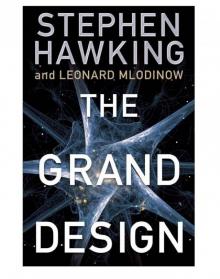 The Grand Design
The Grand Design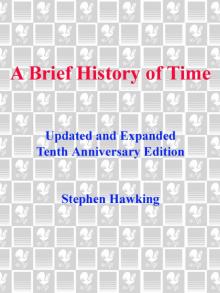 A Brief History of Time
A Brief History of Time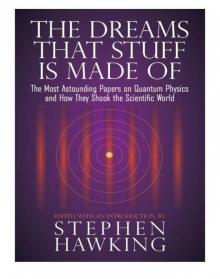 The Dreams That Stuff is Made of
The Dreams That Stuff is Made of My Brief History
My Brief History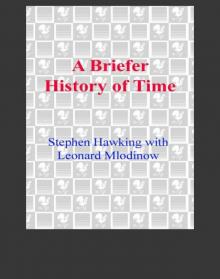 A Briefer History of Time
A Briefer History of Time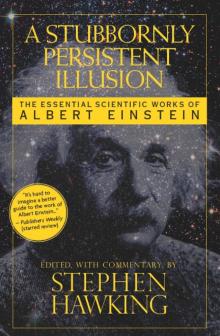 A Stubbornly Persistent Illusion
A Stubbornly Persistent Illusion George and the Blue Moon
George and the Blue Moon George and the Unbreakable Code
George and the Unbreakable Code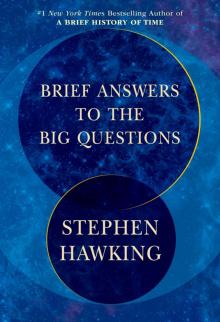 Brief Answers to the Big Questions
Brief Answers to the Big Questions George's Secret Key to the Universe
George's Secret Key to the Universe